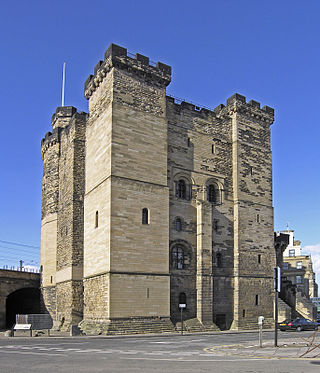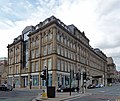
Newcastle upon Tyne, or simply Newcastle, is a city and metropolitan borough in Tyne and Wear, England. It is England's northernmost metropolitan borough, located on the River Tyne's northern bank opposite Gateshead to the south. It is the most populous settlement in the Tyneside conurbation and North East England.

The Tyne Bridge is a through arch bridge over the River Tyne in North East England, linking Newcastle upon Tyne and Gateshead. The bridge was designed by the engineering firm Mott, Hay and Anderson, who later designed the Forth Road Bridge, and was built by Dorman Long and Co. of Middlesbrough. The bridge was officially opened on 10 October 1928 by King George V and has since become a defining symbol of Tyneside. It is ranked as the tenth tallest structure in Newcastle.

Sydney Smirke was a British architect.

The Castle, Newcastle, or Newcastle Castle is a medieval fortification in Newcastle upon Tyne, England, built on the site of the fortress that gave the City of Newcastle its name. The most prominent remaining structures on the site are the Castle Keep, and the Black Gate, its fortified gatehouse.

John Dobson was a 19th-century English neoclassical architect. During his life, he was the most noted architect in Northern England. He designed more than 50 churches and 100 private houses, but he is best known for designing Newcastle railway station and his work with Richard Grainger developing the neoclassical centre of Newcastle. Other notable structures include Nunnykirk Hall, Meldon Park, Mitford Hall, Lilburn Tower, St John the Baptist Church in Otterburn, Northumberland, and Beaufront Castle.

The Theatre Royal is a historic theatre, a Grade I listed building situated on Grey Street in Newcastle upon Tyne.

The history of Newcastle upon Tyne dates back almost 2,000 years, during which it has been controlled by the Romans, the Angles and the Norsemen amongst others. Newcastle upon Tyne was originally known by its Roman name Pons Aelius. The name "Newcastle" has been used since the Norman conquest of England. Due to its prime location on the River Tyne, the town developed greatly during the Middle Ages and it was to play a major role in the Industrial Revolution, being granted city status in 1882. Today, the city is a major retail, commercial and cultural centre.

Gosforth is an area of Newcastle upon Tyne, England, situated north of the City Centre. It constituted a separate urban district of Northumberland from 1895 until 1974 before officially merging with the city of Newcastle upon Tyne. In 2001, it had a population of 23,620.

The Quayside is an area along the banks (quay) of the River Tyne in Newcastle upon Tyne and Gateshead in Tyne and Wear, North East England, United Kingdom.

The Newcastle town wall is a medieval defensive wall, and Scheduled Ancient Monument, in Newcastle upon Tyne, northern England. It was built during the 13th and 14th centuries, and helped protect the town from attack and occupation during times of conflict. It was approximately 3 kilometres (2 mi) long, at least 2 metres (6.5 ft) thick, up to 7.6 metres (25 ft) high, and had six main gates: Close Gate, West Gate, New Gate, Pilgrim Gate, Pandon Gate and Sand Gate. It also had seventeen towers, as well as several smaller turrets and postern gates. The town wall was kept in good repair whilst there was a threat of invasion from Scottish armies, and the town was successfully defended on at least two occasions; but with the decline of the border wars between England and Scotland, the wall was allowed to deteriorate.

Richard Grainger was a builder in Newcastle upon Tyne. He worked with the architects John Dobson and Thomas Oliver, and with the town clerk, John Clayton, to redevelop the centre of Newcastle in the 19th century. Grainger Street and the Grainger Market are named after him; sometimes the whole area of Newcastle developed in the Neoclassical style around Grey Street and Grainger Street is referred to as Grainger Town.

The Tyne Theatre and Opera House is a theatre in Newcastle upon Tyne, England. It is a Grade I listed building, rated "in the top 4% of listed buildings" by English Heritage and is afforded a three star rating by the Theatres Trust, "a very fine theatre of the highest theatrical and architectural quality". It opened in 1867 as the Tyne Theatre and Opera House, designed by the Newcastle upon Tyne architecture practice of William Parnell. The backstage area was damaged by fire in 1985, with subsequent rebuilding restoring the Victorian stage machinery.
A chare, in the dialect of North-east England, is a narrow medieval street or alley.

St Nicholas Hospital is an NHS psychiatric hospital located in Gosforth, Newcastle upon Tyne, England, UK. The entrance is located on Jubilee Road. The buildings range from Victorian-era to modern facilities and occupy 12 hectares of land. The hospital is managed by Cumbria, Northumberland, Tyne and Wear NHS Foundation Trust.
Frank West Rich was an English architect who mainly worked in the Newcastle upon Tyne area.

The Guildhall is an important civic building in Newcastle upon Tyne. It is a Grade I listed building.

Richard Gibson Kyle (1820–1903), known professionally as Gibson Kyle, was an English architect practising in and around Newcastle upon Tyne. His father was a Northumberland journeyman mason and contractor-builder. Kyle was articled to his uncle John Dobson and worked with him on local projects such as Newcastle railway station, some of the Quayside buildings, and the King Street-Queen Street block which was the site of a major fire in 1867.

St Dominic's Church, formerly St Dominic's Priory Church, is a Roman Catholic Parish church in Newcastle-upon-Tyne. It was built from 1869 and opened in 1873. It was founded by the Dominican Order. It is located on New Bridge Street, east of Manors railway station, in the Ouseburn area of Newcastle. It was designed by Archibald Matthias Dunn and is a Grade II listed building.

Nielsen, Andersen & Company was an English firm of merchants, shipbrokers, ship owners and insurance agents based in Newcastle upon Tyne.





















